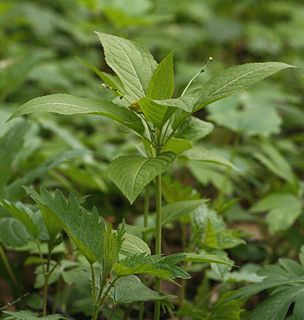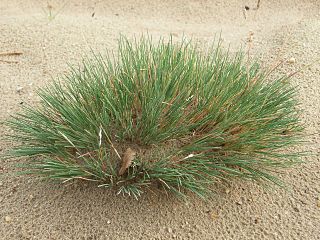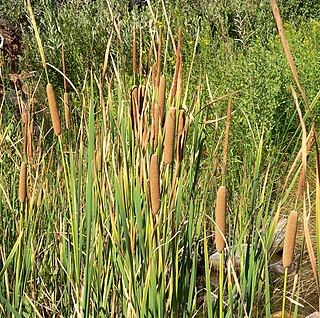
The genus Ophrys is a large group of orchids from the alliance Orchis in the subtribe Orchidinae. They are widespread across much of Europe, North Africa, the Canary Islands, and the Middle East as far east as Turkmenistan.

Arrhenatherum, commonly called oatgrass or button-grass, is a genus of Eurasian and North African plants in grass family.

Mercurialis is a genus of plants in the family Euphorbiaceae, the spurges, known commonly as the mercuries. These are slender herbs (forbs), rhizomatious perennials and woody perennials, native to Europe, North Africa, and Asia.
- Mercurialis annuaL. - most of Europe, North Africa, the Middle East, and islands of the eastern Atlantic
- Mercurialis canariensisObbard & S.A.Harris - Canary Islands
- Mercurialis corsicaCoss. & Kralik - Corsica, Sardinia
- Mercurialis ellipticaLam. - Spain, Portugal, Morocco
- Mercurialis huetiiHanry - Spain, France, Morocco
- Mercurialis leiocarpaSiebold & Zucc. - China, Japan, Korea, Ryukyu Islands, Thailand, Assam, Bhutan, Nepal
- Mercurialis × longifoliaLam. - Spain, Portugal, France (M. annua × M. tomentosa)
- Mercurialis ovataSternb. & Hoppe - C + E Europe and SW Asia from Germany + Italy to Russia + Syria
- Mercurialis × paxiiGraebn. - C + E Europe from Germany to Crimea (M. ovata × M. perennis)
- Mercurialis perennisL. - most of Europe plus Algeria, Caucasus, Turkey, Iran
- Mercurialis reverchoniiRouy - Spain, Morocco
- Mercurialis tomentosaL. - Spain, Portugal, France, Balearic Islands

Orchis anthropophora, the man orchid, is a European species of orchid whose flowers resemble a human figure. The head is formed by the petals and sepals, and the suspended torso and limbs by the lobes of the labellum. It usually grows in calcareous grassland.

Ballota (horehound) is a genus of flowering evergreen perennial plants and subshrubs in the family Lamiaceae. native to temperate regions. The Mediterranean region has the highest diversity in the genus, with more isolated locations in South Africa, Central Asia, northern Europe, and the islands of the eastern North Atlantic. It is found in rocky and waste ground.

Zodarion is a genus of ant-eating spiders from the Zodariidae family. Over 150 species from Eurasia and North Africa have been described as of May 2017.

Anthemis arvensis, also known as corn chamomile, mayweed, scentless chamomile, or field chamomile is a species of flowering plant the genus Anthemis, in the aster family. It is used as an ornamental plant.

Micromeria is a genus of flowering plants in the mint family, Lamiaceae, widespread across Europe, Asia, Africa, and North America, with a center of diversity in the Mediterranean region and the Canary Islands. It is sometimes placed within the genus Satureja. The name is derived from the Greek words μῑκρος (mīkros), meaning "small," and μερίς (meris), meaning "portion," referring to the leaves and flowers.
- Micromeria acropolitanaHalácsy - Greece
- Micromeria albanica(K.Malý) Šilic - Albania, Yugoslavia
- Micromeria × angosturaeP.Pérez Gran Canaria in the Canary Islands (M. tenuis subsp. linkii × M. varia subsp. canariensis)
- Micromeria arganietorum(Emb.) R.Morales - Morocco
- Micromeria benthamiiWebb & Berthel. - Gran Canaria in the Canary Islands
- Micromeria × benthamineolensSvent. - Gran Canaria in the Canary Islands (M. benthamii × M. pineolens)
- Micromeria biflora(Buch.-Ham. ex D.Don) Benth. - Himalayas from Afghanistan to Myanmar
- Micromeria × bourlieriMaire & Le Lièvre - Algeria, Morocco (M. graeca × M. inodora)
- Micromeria brivesiiBatt. - Morocco
- Micromeria × broussonetiiA.Santos, A.Acev.-Rodr. & Reyes-Bet. - Canary Islands (M. densiflora × M. varia)
- Micromeria browicziiZiel. & Kit Tan - Greece
- Micromeria chionistraeMeikle - Cyprus
- Micromeria conferta(Coss. & Daveau) Stefani - Libya
- Micromeria × confusaG.Kunkel & P.Pérez - Gran Canaria in the Canary Islands (M. benthamii × M. lanata)
- Micromeria cremnophilaBoiss. & Heldr. - Albania, Greece, Turkey, Syria, Lebanon
- Micromeria cristata(Hampe) Griseb. - Albania, Greece, Yugoslavia, Turkey, Bulgaria, Iran, Cyprus
- Micromeria croatica(Pers.) Schott - Albania, Yugoslavia
- Micromeria cymuligeraBoiss. & Hausskn. - Turkey
- Micromeria danaensisDanin - Jordan
- Micromeria debilisPomel - Algeria, Morocco
- Micromeria densifloraBenth. - Tenerife in the Canary Islands
- Micromeria douglasii(Benth.) Benth. – Yerba buena - Alaska, British Columbia, Washington, Oregon, California, Idaho, Montana
- Micromeria ellipticaK.Koch - Turkey
- Micromeria filiformis(Aiton) Benth. - Corsica, Sardinia, Balearic Islands
- Micromeria flacca(Nábelek) Hedge - Turkey, Iraq
- Micromeria flagellarisBaker - Madagascar
- Micromeria fontanesiiPomel - Algeria, Morocco
- Micromeria forbesiiBenth. - Cape Verde Islands
- Micromeria fruticosa(L.) Druce - Eastern Mediterranean
- Micromeria glomerataP.Pérez - Tenerife in the Canary Islands
- Micromeria graeca(L.) Benth. ex Rchb. - Mediterranean from Morocco + Portugal to Turkey
- Micromeria guichardii(Quézel & Zaffran) Brullo & Furnari - Libya
- Micromeria hedgeiRech.f. - Iran
- Micromeria helianthemifoliaWebb & Berthel. - Gran Canaria in the Canary Islands
- Micromeria herpyllomorphaWebb & Berthel. - La Palma in the Canary Islands
- Micromeria hispidaBoiss. & Heldr. ex Benth. - Crete
- Micromeria hochreutineri(Briq.) Maire - Algeria, Morocco
- Micromeria × hybridaZagan - Greece including Crete (M. graeca × M. nervosa)
- Micromeria hyssopifoliaWebb & Berthel. - Tenerife + El Hierro in the Canary Islands
- Micromeria imbricata (Forssk.)C.Chr. - Africa from Nigeria to Ethiopia to Transvaal, Arabian Peninsula
- Micromeria inodora(Desf.) Benth. - Algeria, Morocco, Tunisia, Spain including Balearic Islands
- Micromeria × intermediaG.Kunkel & P.Pérez - Gran Canaria in the Canary Islands (M. benthamii × M. helianthemifolia)
- Micromeria juliana(L.) Benth. ex Rchb. - Mediterranean
- Micromeria kerneriMurb. - Yugoslavia
- Micromeria lachnophyllaWebb & Berthel. - Tenerife in the Canary Islands
- Micromeria lanata(C.Sm. ex Link) Benth. - Gran Canaria in the Canary Islands
- Micromeria lasiophyllaWebb & Berthel. - Canary Islands
- Micromeria lepidaWebb & Berthel. La Gomera in the Canary Islands
- Micromeria leucanthaSvent. ex P.Pérez - Gran Canaria in the Canary Islands
- Micromeria longipedunculataBräuchler - Yugoslavia, Albania
- Micromeria macrosiphonCoss. - Morocco
- Micromeria madagascariensisBaker - Madagascar
- Micromeria marginata(Sm.) Chater - Alpes Maritimes in France, Liguria + Sardinia in Italy
- Micromeria × meteoricaHausskn. - Greece (M. cremnophila × M. juliana)
- Micromeria microphylla(d'Urv.) Benth. - Balearic Islands, Sicily, Malta, southern mainland Italy, Crete, Cyprus, Libya
- Micromeria monantha(Font Quer) R.Morales - Morocco
- Micromeria myrtifoliaBoiss. & Hohen. - from Greece to Iran
- Micromeria nervosa(Desf.) Benth. - Mediterranean from Algeria + Balearic Islands to Turkey
- Micromeria × nogalesiiG.Kunkel & P.Pérez - Gran Canaria in the Canary Islands
- Micromeria peltieri(Maire) R.Morales - Morocco
- Micromeria × perez-paziiG.Kunkel - Gran Canaria in the Canary Islands (M. benthamii × M. tenuis)
- Micromeria persicaBoiss. - Iran, Iraq, Turkey
- Micromeria pineolensSvent. - Gran Canaria in the Canary Islands
- Micromeria × preauxiiWebb & Berthel. - Gran Canaria in the Canary Islands (M. benthamii × M. varia subsp. canariensis)
- Micromeria pseudocroaticaŠilic - Yugoslavia
- Micromeria rivas-martineziiWildpret - Tenerife in the Canary Islands
- Micromeria serbalianaDanin & Hedge - Sinai
- Micromeria sinaicaBenth. - Sinai, Israel
- Micromeria sphacioticaBoiss. & Heldr. ex Benth.- Crete
- Micromeria sphaerophyllaBaker - Madagascar
- Micromeria suborbicularis(Alain) Borhidi - Cuba
- Micromeria × tagananensisP.Pérez - Tenerife in the Canary Islands (M. glomerata × M. varia)
- Micromeria teneriffae(Poir.) Benth. ex G.Don - Tenerife in the Canary Islands
- Micromeria tenuis(Link) Webb & Berthel. - Gran Canaria in the Canary Islands
- Micromeria unguentariaSchweinf. - Ethiopia
- Micromeria variaBenth. - Canary Islands, Madeira, Cape Verde Islands
- Micromeria weilleri(Maire) R.Morales - Morocco
- Micromeria × wildpretiiP.Pérez - Tenerife in the Canary Islands (M. rivas-martinezii × M. varia)

Vulpia is a widespread genus of plants in the grass family, native to many countries around the world and naturalized in many of the nations to which it is not native. It is most common in temperate regions.

{{taxobox |name =Romulea |image =Romulea bulbocodium 1.jpg |image_caption =Romulea bulbocodium |regnum =Plantae |unranked_divisio =Angiosperms |unranked_classis =Monocots |ordo =Asparagales |familia =Iridaceae |subfamilia =Ixioideae |tribus =Ixieae |genus =Romulea |genus_authority =Maratti |type_species =Romulea bulbocodium |type_species_authority =(L.) Sebastiani & Mauri |synonyms_ref= |synonyms=*BulbocodiumGronov. 1755 not L. 1753 nor Ludw. ex Kuntze 1891

Rostraria is a genus of plants in the grass family, native primarily to Eurasia and North Africa with one species native to South America. Hairgrass is a common name.

Periballia is a genus of Mediterranean plants in the grass family.
- Periballia involucrata(Cav.) Janka - Spain, Portugal
- Periballia laevis(Brot.) Asch. & Graebn. - Spain, Portugal, Morocco, Crimea; naturalized in parts of United States
- Periballia minuta(L.) Asch. & Graebn. - Spain, Portugal, France incl Corsica, Italy incl Sicily + Sardinia, Greece, Bulgaria, Albania, Croatia, European Turkey, Algeria, Morocco; naturalized in South Africa + Australia

Corynephorus is a genus of European, North African, and Middle Eastern plants in the grass family.
- Corynephorus canescens(L.) P.Beauv. - Europe, Morocco
- Corynephorus deschampsioidesBornm. - Syria, Israel, Jordan, Palestine
- Corynephorus divaricatus(Pourr.) Breistr. - Mediterranean and nearby regions from Spain + Morocco to Iran
- Corynephorus fasciculatusBoiss. & Reut. - Portugal, Spain, France incl Corsica, Sardinia, Sicily, Algeria
- Corynephorus macrantherusBoiss. & Reut. - Portugal, Spain, Morocco, Algeria, Tunisia
Cutandia is a genus of Asian and Mediterranean plants in the grass family. It is native to lands extending from Portugal and Cape Verde to Pakistan and Kazakhstan.
- Cutandia dichotoma(Forssk.) Trab. - Asia + Africa from Algeria to Iran
- Cutandia divaricata(Desf.) Benth. - Canary Islands, Spain, Italy, Morocco, Algeria, Tunisia, Libya
- Cutandia maritima(L.) Benth. - Mediterranean, Canary Islands
- Cutandia memphitica(Spreng.) Benth. - Spain, North Africa, Canary Islands, Cape Verde, Middle East, Caucasus, Arabian Peninsula, Iran, Pakistan, Afghanistan, Central Asia
- Cutandia rigescens(Grossh.) Tzvelev - Caucasus, Kazakhstan, Uzbekistan
- Cutandia stenostachya(Boiss.) Stace - Greece + Turkey including Aegean Islands
Triplachne is a genus of seaside plants in the grass family, native to shorelines in the Mediterranean region from the Canary Islands to Turkey. The only known species is Triplachne nitens, called shining grass. It is native to Spain, Portugal, Sicily, Greece, Algeria, Morocco, Libya, Tunisia, Egypt, Turkey, Cyprus, Palestine, Israel.
Vulpiella is a genus of plants in the grass family. The only known species is Vulpiella stipoides, native to the western Mediterranean region.

Coleostephus is a genus of flowering plants in the family Asteraceae.
- Coleostephus multicaulis(Desf.) Durieu - Algeria
- Coleostephus myconis(L.) Cass. - Spain, Portugal, France, Corsica, Sardinia, Italy, Yugoslavia, Greece, Algeria, Morocco
- Coleostephus paludosus(Durieu) Alavi - Spain, Portugal, Corsica, Sardinia, Italy, Sicily, Algeria, Tunisia, Libya

Typha domingensis, known commonly as southern cattail or cumbungi, is a perennial herbaceous plant of the genus Typha.

Frankenia laevis, commonly sea heath, is a low shrub in the family Frankeniaceae. It is native to south-west Europe and Britain and to northwestern Africa, including Macaronesia. It grows on the coast. It is rare in the Britain.
Bryotropha plebejella is a moth of the family Gelechiidae. It is found in Portugal, Spain, southern France, Corsica, Sardinia, Sicily, Croatia, the Republic of Macedonia, Greece, the Aegean Islands, Crete, Cyprus, Turkey, Syria, Israel, Algeria, Tunisia, Libya, Madeira and the Canary Islands.

















